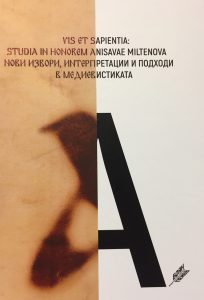STUDYING STANISLAV’S READING MENOLOGION: ISSUES AND APPROACHES
A conference will be held at the University of Sofia on May 21st on the topic of the Stanislav Reading Menologion. The day-long conference, which is a part of the project “Reconstruction of the Preslav Hagiographical Collections: the Study and Publication of the Stanislav Reading Menologion” (see description of project below),* aims to bring together scholars from different areas of Palaeoslavic studies who have research experience with manuscript No. 1039, preserved in the SS. Cyril and Methodius National Library of Bulgaria in Sofia.
Discussion topics include:
- History of the manuscript
- Characteristics of the codex
- Codicological, paleographic, linguistic, textological features
- Translation and adaptation of original Byzantine hagiographical texts in a South Slavic context
- Digital resources, providing access to medieval Slavonic texts and codices.
Program
Първо заседание/ Session 1 (9:00 – 11:00)
Проф. дфн Боряна Христова (НБКМ, София) Думи за ръкопис № 1039 (Станиславов чети-миней) от НБКМ / Words about Ms. 1039 (Stanislav’s Menologion) from the National Library in Sofia
Проф. д-р Климентина Иванова (СУ, КМНЦ, София) Представянето на староизводните чети-минеи в Bibliotheca Hagiographica Balcano–Slavica (BHBS) и проблемите, които остават нерешени/The Place of the Old Redaction Menologia in Bibliotheca Hagiographica Balcano–Slavica (BHBS): Cases Unsolved
Проф. чл. кор. Иван Добрев (София) Лексикални особености в ръкопис № 1039 (Станиславов чети-миней) /Lexical Characteristics of Ms. 1039 (Stanislav’s Menologion)
Проф. дфн Боряна Велчева (София) За показателните местоимения в ръкопис № 1039/About the Demonstrative Pronouns in Ms. 1039
Дискусия /Discussion
Кафе пауза /Coffee Break
Второ заседание/ Session 2 (11:10 – 13:00)
Д-р Явор Милтенов (ИБЕ, БАН, София) Бележки върху състава и историята на НБКМ 1039/Notes On the Content and History of Ms.1039 from the National Library in Sofia
Д-р Диана Атанасова (СУ, София) Станиславовият чети-миней и институционализираното четене (особености на състава и ролята на Устава)/ Stanislav’s Menologion and the Institutionalized Reading (Content Characteristics and Role of the Typicon)
Д-р Анета Димитрова (СУ, София) Йоан Златоуст в ръкопис № 1039 от НБКМ/ St. John Chrysostom in Ms. 1039 from the National Library in Sofia
Проф. дфн Искра Христова-Шомова (СУ, София) Съставът на ранните славянски празнични минеи в съпоставка със състава на ранните чети-сборници/Comparative Study of the Contents of the Early Festal Menaia and of the Early Reading Miscellanies
Дискусия /Discussion
Обедна почивка/ Lunch Break
Трето заседание/ Session 3 (14:00 – 15:30)
Доц. д-р Андрей Бояджиев (СУ, София) Палеографски и езикови наблюдения върху ръкописис № 1039 от НБКМ/Paleographic and Language Observations on Ms. 1039 from National Library in Sofia
Докт. Цветомира Данова (КМНЦ, София) Слово за Въздвижение на кръста от св. Андрей Критски по ръкопис НБКМ 1039 /The Homily on the Elevation of the Cross by St. Andrew of Crete in Ms. 1039 from the National Library in Sofia
Д-р Мая Петрова-Танева (ИЛ, БАН, София) Житието на Ефросина Александрийска в Станиславовия чети-миней (НБКМ 1039) от XIV в./The Life of St Euphrosyne of Alexandria in the Stanislav’s Menologion (Ms. 1039) from the Fourteenth Century
Prof. Dieter Stern (Universiteit Gent, Belgium) Deviations from Literalism: Remarks on the Slavic Translation of the Greek Life of Abraham of Qidun /Отклонения от буквализма: коментар върху славянския превод на гръцкото Житие на преподобния Аврамий
Дискусия /Discussion
Кафе пауза /Coffee Break
Четвърто заседание/ Session 4 (15:40 – 18:00)
Dr. Małgorzata Skowronek (Uniwersytet Łódzki) Култът към св. Архангели и други безплътни сили в Станиславовия чети-миней/ The Cult of St. Archangels and Other Bodiless Powers in Stanislav’s Menologion
Д-р Любка Ненова (ЮЗУ, Благоевград) Някои езикови особености в Житието на св. Йоан Милостиви от ръкопис НБКМ 1039/ Some Linguistic Characteristics of the Life of St. John the Merciful in Мs. 1039 from the National Library in Sofia
Dr. Lara Sels (Katholieke Universiteit Leuven/ Universiteit Gent, Belgium) Prof. David J. Birnbaum (University of Pittsburgh, USA) Editing the Bdinski Sbornik as a Multilayered Reality/ За издаването на Бдинския сборник като многопластова реалност
Проф. дфн Анна-Мария Тотоманова (СУ, София) Електронни инструменти за обработка на средновековни славянски текстове/ е-Tools for Processing Medieval Slavic Texts
Д-р Диана Атанасова (СУ, София), докт. Козма Поповски (КМНЦ, София) Представяне на сайта Hagioslavica/ Presentation of the Website Hagioslavica
Дискусия /Discussion
Закриване на конференцията/ Closing of the Conference
* * *
Конференцията е във връзка с изследователски проект „Реконструкция на преславските агиографски сборници: издание и изследване на Станиславовия чети-миней” (ДМУ 03/19), финансиран от Фонд „Научни изследвания” към МОНМ.
*Reconstruction of the Preslav Hagiographical Collections: Study and Publication of the Stanislav’s Menologion” is the title of a project developed by a team of young Bulgarian medievalists. Its principal task is the preparation and publication (both digital and traditional) and research of Stanislav’s Menologion (better known as manuscript No. 1039 from the National Library in Sofia). It is one of the most valuable medieval Slavic manuscripts, preserved in the “St. St. Cyril and Methodius“ National Library. Stanislav’s Menologion is significant because, although it is a 14th-century copy, it preserves a number of archaic texts that allow us to reconstruct faithfully the original contents of menologia that were compiled and translated during the Golden Age of medieval Bulgarian literature and culture.
Source: Email from Diana Atanassova.







